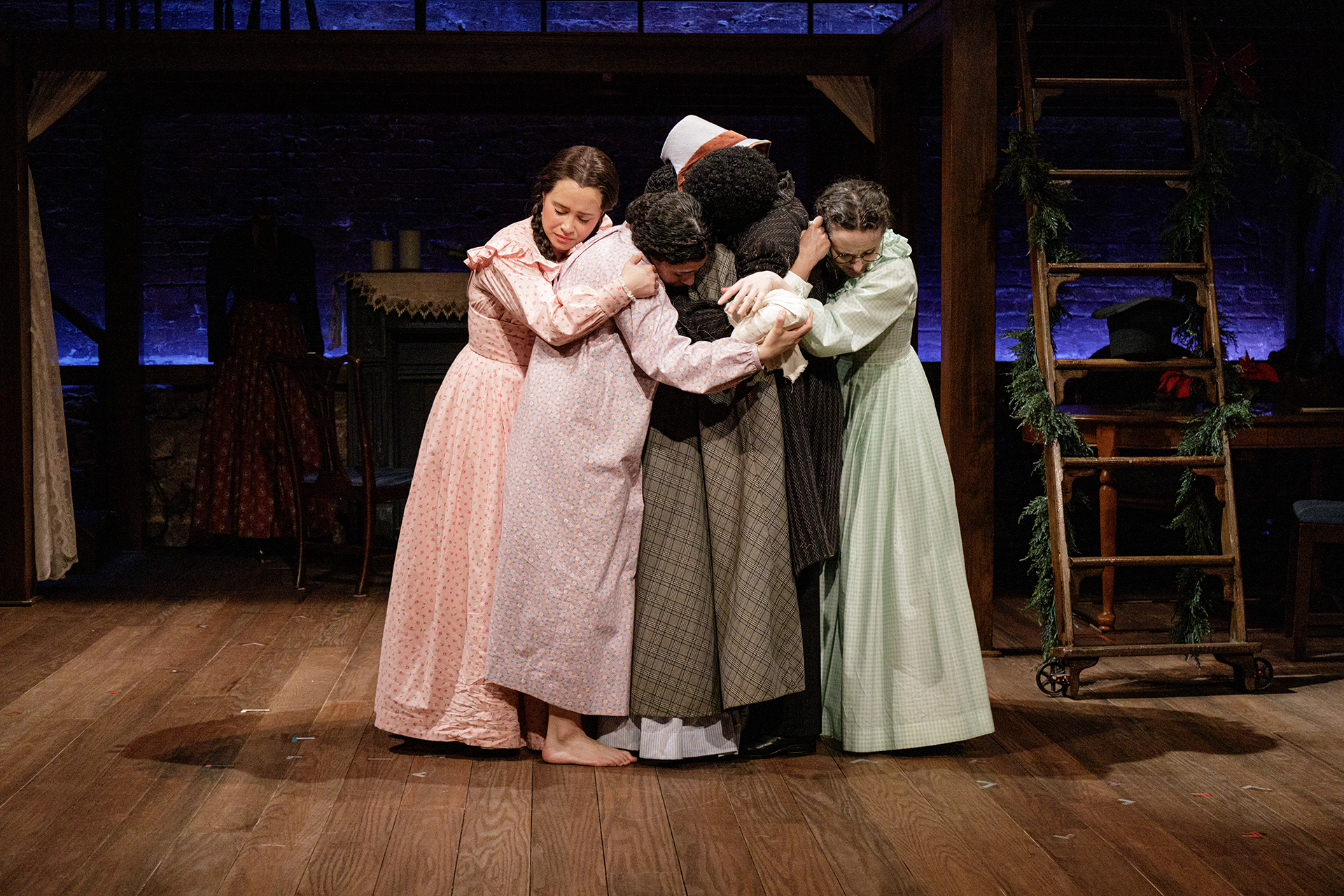Hamill’s ‘Little Women’ and ‘Convention’

Bearing the stamp of playwright Kate Hamill, this “Little Women” is a testament of late 20th-Century feminism. Hamill, who has famously adapted classics “Sense and Sensibility” and “Vanity Fair” to the stage, finds fodder in well-known women’s roles — women of complexity, that is.
Her novel-to-stage adaptations can feel boisterous, bursting with a kind of giddy zeal. To that end, Louisa May Alcott’s 1868 novel, “Little Women,” offers a basketful of melodramatic skits, exaggerated characterizations, great storytelling, and the buoyancy that allows us to lift the images from the page. It’s still a foreshadowing to watch Katharine Hepburn’s broadly comedic portrayal of Jo in the 1933 movie.
Many remakes later, and we now have this play produced by Primary Stages at The Cherry Lane Theater in which Jo, the central character, is portrayed by the African American actress, Kristolyn Lloyd. In her portrayal, Jo doesn’t experience herself being like other women. She’s a writer, and she dresses like a man. And while dress ups are central for acting out her skits, Jo maintains a seriousness of purpose that becomes her. She definitely has anti-establishment charm, and a lot of resistance to “ladylike.”
The beauty of the piece, as in Hamill’s “Sense and Sensibility,” is in the ensemble nature of the production. Director Sarna Lapine deftly weaves this on-stage family, with its four distinctly different sisters.
Thanks to a zesty Act II, we get to follow the characters to their individual destinies, and in the process, discover the nuances of character that forge empathy. Beth, played by Paola Sanchez Abreu is an especially sensitive character.
In the role of Meg, Kate Hamill transforms from the dutiful good girl, and the most feminine of the sisters, to the haggard wife of a tutor, and mother of twins. It’s a ravishing role, the twins screaming and crying and the constant house cleaning are enough to drive her out of her mind. It’s the reality of marriage as described here that underlines the play’s contemporary spin. Her life serves as a sharp contrast to the life Jo has chosen for herself.
Clearly, in such an adaptation, characters that appear in the novel are eliminated, or blended into other characters who can express their views. Here, the poor Hummels, secondary characters in the novel, are only mentioned as emblems of poverty. It’s a big concern for the sisters, whose lives have gone from riches to rags. Speaking of domestic tensions, the story takes place during the Civil War.
Given the circumstances into which the liberal thinking March family has fallen, it’s appropriate that the entire production takes place on a single set. Mikiko Suzuki MacAdams’s dark and wooden living space, with a loft above carrying a small bed feels cold when there aren’t a lot of characters running about. Otherwise, it’s a home worthy of spiritual riches — piano playing, rambunctious acting, and the romantic lives that blossom for each of these four sisters.
Convention
A wild romp at the Irondale Theater in Brooklyn, “Convention” takes us back to the 1944 Democratic convention. FDR is running for his fourth term, and the issue on the floor concerns his pick for Vice President, with Harry Truman beating the incumbent, Henry A. Wallace.
Think Bernie Sanders, and the 2016 Democratic convention, and you can begin to imagine the tumult on stage. Soon, several vice-presidential candidates throw their hats into the ring. Insults, jibes, innuendoes walk the tightrope here. That, and a hot dog vendor keep the action going.
Staged as a real-time event, in which the actors portraying the vying politicians merge into, and out of the audience, “Convention” is not linear in structure. Why these candidates emerge when they do, or what really went down to cause Truman’s election is not to be clarified. As written by Danny Rocco, that is the fabric of history — more like a Sargasso Sea than an Excel spreadsheet. Stuff happens. It’s a dirty war. Still, watching it is fun!
Set in a beautiful hall, housed in the Lafayette Church in Fort Greene, the surroundings bring us back to 1944, with walls of chipping paint, and old wooden seats. Ragtime piano music also marks the affinity with African American culture, and reflects the progressive temperament Wallace’s team flaunted.
Democratic rusticity abounds. (This is nothing like the glitter the Republican Party puts on.) And Jennifer Raskopf’s period costumes are a hoot. Truman’s wife wears a dowdy skirt suit, and a little hat, but as played by Daniel John Serpati, a tall ivy league looking man, it looks ludicrous. Similarly, women in pant suits portraying men as well as women, mingle among us.
Inclusiveness has a strong presence here. Charles Everett, the African American actor, plays Truman, and Claire Mikelle Anderson, in the role of Wallace, is convincing, while not necessarily manlier in her role.
Directed by Shannon Fillion, the hall turns into something of an echo chamber, in which each audience member hears different voices. The banter going on next to my seat can’t be noticed at the other end of the auditorium. And what they saw and heard is not what I can observe. It’s cacophonous that way.
Still, the conversation sounds like contemporary partisan bickering. One representative shouts, “We’re all Democrats. We’re all on the same team.” To which another responds, “But we’re not. That’s the problem.” Better yet, “You’re like birds tweeting. Use your minds!”
Clearly, the issues that are being voiced are those of our own time. Here the conflict between the progressives, represented by Wallace, and the more moderate position championed by Truman, has a lot to do with what the party can serve that voters will buy.
Cheering at the end of Act I, “It’s 1944. What are you waiting for?” is the show’s battle call, an impetus to people who wonder why we vote.



